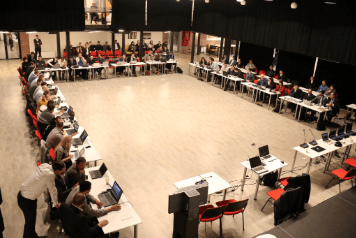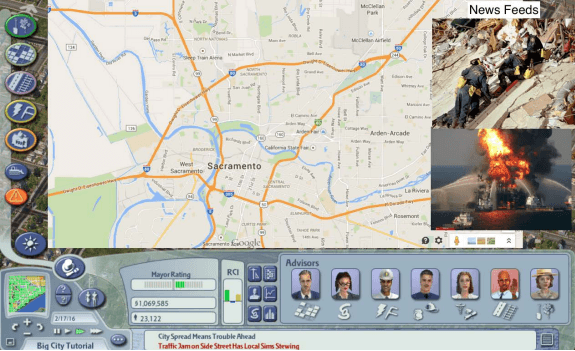Gamification In The Public Sector
Gamification engages folks at an emotional degree, which is much extra highly effective than typical transactional engagement methods.
— Brian Burke, Gamify: How Gamification Motivates Folks to Do Extraordinary Issues
Authorities coaching has by no means been extra crucial or extra advanced. From energetic shooter preparedness to cybersecurity readiness, public servants are more and more known as to navigate high-stakes eventualities the place choices can have life-or-death penalties. Conventional coaching strategies like static shows, dense manuals, or rare workshops typically fail to interact or put together contributors for the dynamic challenges they face.
Enter gamification: the applying of sport design rules to non-game contexts. In authorities coaching, gamification is greater than a buzzword; it is a confirmed method that enhances engagement, boosts data retention, and builds real-world readiness. Whether or not it is utilizing Augmented Actuality to simulate emergencies, creating critical video games for catastrophe response, or immersing cyber groups in high-risk assault eventualities, authorities businesses are embracing gamified studying to rework coaching right into a hands-on, high-impact expertise.
Let’s discover how three distinguished examples—DHS’s AR-based energetic shooter coaching, FEMA’s critical video games, and the ITU’s Cyber Ranges—reveal the ability and potential of gamification within the public sector.
Examples Of Gamification In Authorities
DHS: Augmented Actuality For Lively Shooter Coaching
By means of the Nationwide City Safety Expertise Laboratory (NUSTL), the U.S. Division of Homeland Safety (DHS) has deployed Augmented Actuality (AR) techniques to assist energetic shooter response coaching. [1] These techniques overlay digital threats and objects onto real-world environments, turning an unusual classroom or workplace right into a dynamic coaching floor. Trainees transfer by way of bodily areas whereas responding to digital simulation, all offered in actual time by way of AR headsets or cellular units.
Picture from dhs.gov [1]
Why It Works
AR gamifies the atmosphere itself, offering immersive suggestions loops that mimic real-life stressors. Individuals should assess dangers, make choices, and talk beneath strain—similar to they might throughout an precise emergency. This hands-on, scenario-based coaching improves situational consciousness and enhances retention far past conventional lecture-based codecs.
The outcome? First responders exit with muscle reminiscence and confidence that static drills not often present.
FEMA: Severe Video games For Catastrophe Response
The Federal Emergency Administration Company (FEMA) makes use of critical video games—interactive, scenario-based simulations—to organize public officers for pure disasters and complicated emergencies. [2] One instance is FEMA’s Emergency Administration Institute’s Digital Tabletop Workouts (VTTX), which permit contributors to role-play catastrophe eventualities in a digital atmosphere. Whether or not coordinating a hurricane evacuation or responding to a chemical spill, gamers make choices, allocate sources, and adapt to altering circumstances.
Why It Works
Severe video games reinforce techniques considering, permitting contributors to see how their choices influence others in actual time. Additionally they foster cross-agency collaboration, since gamers should work as groups to handle multifaceted challenges. With built-in scoring, time constraints, and post-game suggestions, these simulations create a compelling studying expertise that displays the complexity of real-life disaster administration.
FEMA’s use of gamification helps not solely readiness but additionally crucial reflection, enabling leaders to check their protocols and enhance them earlier than a catastrophe ever strikes.
ITU: Cyber Ranges And Worldwide Menace Response
The Worldwide Telecommunication Union (ITU)—a UN company—makes use of Cyber Ranges to coach nationwide, regional, and international cyber response groups on tips on how to confront digital threats like ransomware, DDoS assaults, and important infrastructure hacks. [3] These gamified simulations place contributors in a digital atmosphere the place they have to defend networks, establish vulnerabilities, and comprise assaults beneath time strain.

Picture from itu.int [3]
Why It Works
Cybersecurity threats evolve quickly, and conventional “guidelines” coaching is inadequate. Cyber Ranges create high-fidelity simulations that mimic the complexity of recent cyber warfare. Gamification parts—scoring techniques, simulated adversaries, real-time incident escalations—drive engagement and construct the sensible abilities wanted for contemporary digital defence.
What makes ITU’s method particularly highly effective is its collaborative international focus. Groups from completely different international locations can have interaction in shared simulations, selling shared requirements, fast skill-building, and worldwide cybersecurity resilience.
Why Gamification Issues For Authorities Coaching
These examples reveal a bigger fact: gamification is not nearly enjoyable—it is about perform. In high-stakes fields the place lives, safety, and public belief are on the road, gamification presents:
- Engagement – Interactive eventualities enhance learner motivation and cut back cognitive fatigue.
- Retention – Gamified coaching prompts a number of studying modalities (visible, auditory, kinesthetic), enhancing reminiscence and understanding.
- Suggestions – Actual-time scoring and debriefs present actionable insights for learners and leaders.
- Adaptability – Simulations may be custom-made for various audiences and altering threats.
- Collaboration – Group-based gameplay fosters cross-functional coordination and communication.
As expertise evolves and public challenges develop extra advanced, gamification continues to play a significant position in making ready authorities professionals—not simply to study, however to steer in disaster.
From Augmented Actuality in legislation enforcement to catastrophe response video games and cyber warfare simulations, gamification is now not a future development; it is a present crucial. For businesses in search of to construct resilient, ready, and agile groups, it is time to elevate the method with game-based studying.
References:
[1] Augmented Actuality (AR) Coaching Techniques for First Responders
[2] Severe video games in FEMA Regional Response
[3] CyberDrills



